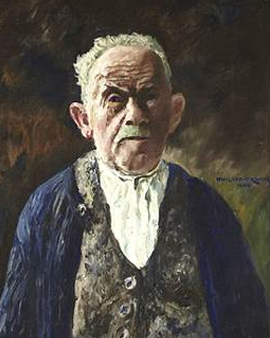The painter and draughtsman Philipp Franck was born on 1860 in Frankfurt am Main in Germany. Although he was a master of his profession, Franck's origins did not lie in painting. On his father's advice, Franck attended the Frankfurt Gewerbeschule (trade school) as a young man after graduating from school. Here he was to be trained as an architect. After his father's death, however, Franck reconsidered his decision, which he did not consider his own, and dropped out of his studies. From now on he devoted himself to his passion, painting. At the age of 17, he began studying fine arts at the renowned Städelschule in Frankfurt. Even during Franck's lifetime, the Städelschule already had a good reputation in the international art scene and offered graduates excellent career prospects. Franck was a student of the artists Heinrich Hasselhorst and Eduard Jakob von Steinle. Steinle was the one who encouraged Franck to illustrate animated fairy tales.
In 1879 Frank moved to the small neighbouring town of Kronberg im Taunus. There the young artist joined an ambitious artist colony. Here Franck met the painter Anton Burger and took private lessons with him for three years. Surrounded by inspiring colleagues and a breathtaking landscape, Franck was able to develop his own ideas about the representation of nature in Kronberg im Taunus. On the recommendation of the painter Jakob Fürchtegott Dielmann, the determined young Franck decided to begin studies at the highly respected Düsseldorf Art Academy. Eduard Gebhardt and Eugen Dücker were his teachers there until he graduated in 1886.
After many years of study, the 26-year-old decided it was time to travel. He settled in Würzburg for a long time before he moved on to Berlin, disappointed by the barren years. Then as now, Berlin was the lifeline of all creative people and those who thought differently. In the colourful city, Franck exhibited his works with the most important figures of the art world of the time - such as Lovis Corinth and Max Liebermann, the founders of the Berlin Secession.
In 1906 Franck, who had become a husband and father, settled down and moved with his family to Wannsee near Berlin. Away from the lively big city, he wanted to establish his own artists' colony based on the model of his past experiences. The experiment failed. However, he proved to be a wonderful open-air painter. Here he created some of his most famous works: family portraits and motifs around the Wannsee.
Philipp Franck died in Berlin at the age of 83. He left behind generations of famous descendants such as the chemist Hans Heinrich Franck, the architect Carl Ludwig Franck, the sculptor Ingeborg Hunzinger and the writer Julia Franck.
×





.jpg)
.jpg)
.jpg)
.jpg)
.jpg)
.jpg)
.jpg)
.jpg)
.jpg)
.jpg)
.jpg)
.jpg)
.jpg)
.jpg)
.jpg)
.jpg)
.jpg)
.jpg)
.jpg)
.jpg)
.jpg)
.jpg)
.jpg)
.jpg)
.jpg)
.jpg)
.jpg)
.jpg)
.jpg)
.jpg)
.jpg)
.jpg)
.jpg)
.jpg)
.jpg)
.jpg)
.jpg)
.jpg)
.jpg)
.jpg)
.jpg)
.jpg)
.jpg)
.jpg)
.jpg)
.jpg)
.jpg)
.jpg)
.jpg)
.jpg)
.jpg)
.jpg)
.jpg)
.jpg)
.jpg)
.jpg)
.jpg)
.jpg)
.jpg)
.jpg)
.jpg)
.jpg)
.jpg)
.jpg)
.jpg)
.jpg)
.jpg)
.jpg)
.jpg)
.jpg)
.jpg)
.jpg)
.jpg)
.jpg)
.jpg)
.jpg)
.jpg)
.jpg)
.jpg)
.jpg)
.jpg)
.jpg)
.jpg)
.jpg)
.jpg)
.jpg)
.jpg)
.jpg)
.jpg)
.jpg)
.jpg)
.jpg)
.jpg)
.jpg)
.jpg)
.jpg)
.jpg)
.jpg)
.jpg)
.jpg)
.jpg)
.jpg)
.jpg)
.jpg)
.jpg)
.jpg)
.jpg)
.jpg)
.jpg)
.jpg)
.jpg)
.jpg)
.jpg)
.jpg)
.jpg)
.jpg)
.jpg)
.jpg)
.jpg)
.jpg)
.jpg)
.jpg)
.jpg)
.jpg)
.jpg)
.jpg)
.jpg)
.jpg)
.jpg)
.jpg)
.jpg)
.jpg)
.jpg)
.jpg)
.jpg)
.jpg)
.jpg)
.jpg)
.jpg)
.jpg)
.jpg)
.jpg)
.jpg)
.jpg)
.jpg)
.jpg)
.jpg)
.jpg)
.jpg)
.jpg)
.jpg)
.jpg)
.jpg)
.jpg)
.jpg)
.jpg)
.jpg)
.jpg)
.jpg)
.jpg)
.jpg)
.jpg)
.jpg)
.jpg)
.jpg)
.jpg)
.jpg)
.jpg)
.jpg)
.jpg)
.jpg)
.jpg)
.jpg)
.jpg)






